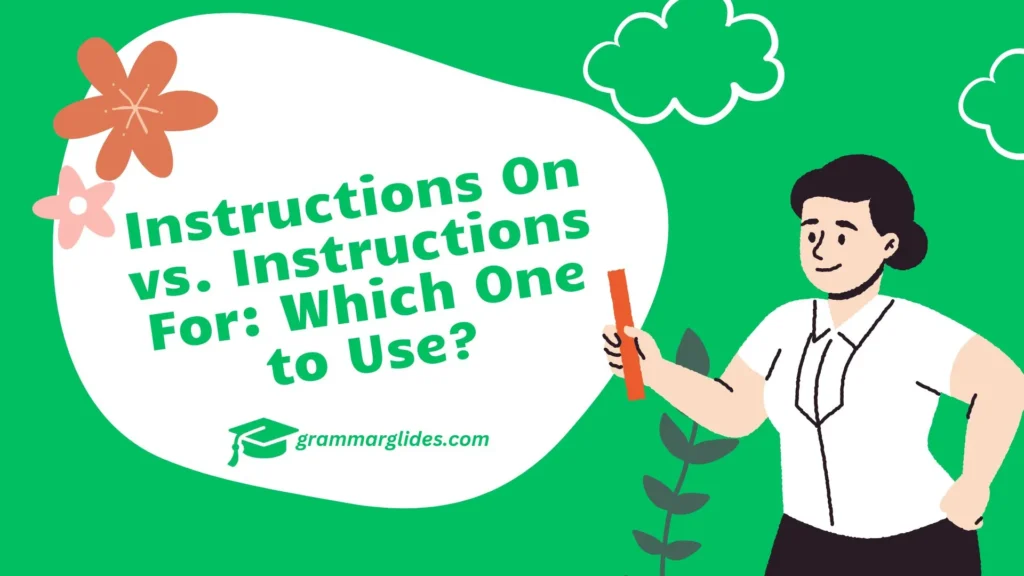“Understanding the right preposition makes a significant difference in communication.”
Clear communication is essential in both spoken and written language. Choosing the correct preposition—such as “on” or “for”—can impact how well your instructions are understood. This blog explores these nuances to make you a pro at choosing the right preposition.
Why is this important? Effective instructions not only simplify processes but also prevent confusion. Dive into this guide to enhance your communication skills and avoid common grammatical pitfalls.
Prepositions might seem small, but they carry immense weight in how ideas are conveyed. Whether you’re giving instructions on how to complete a task or instructions for a specific purpose, understanding these subtle differences is key to mastering the art of clear communication.
Overview
Prepositions like “on” and “for” play pivotal roles in providing precise instructions. While both terms are used widely, they have distinct meanings and applications. This blog will break down their definitions, uses, and practical tips to help you determine which one fits your context. By mastering their differences, you’ll improve your clarity and confidence in delivering instructions.
Understanding the Basics
Definition of “Instructions”
Instructions are detailed steps or guidelines given to someone to accomplish a task or understand a concept. They are designed to make processes more efficient and outcomes more predictable. For example:
- “Follow these instructions to assemble the furniture.”
- “She gave clear instructions for completing the form.”
- “Read the instructions carefully before using the product.”
Each instruction conveys a specific purpose and depends on context for clarity.
Role of Prepositions
Prepositions are small but powerful words that show the relationship between a noun and other words in a sentence. They provide context, direction, or purpose to the instructions. When using “on” or “for,” the choice of preposition determines the tone, focus, and intent of your message.
Instructions On

Definition and Usage
“Instructions on” refers to detailed guidance about a specific topic or method. It emphasizes explaining how something should be done.
For example:
- “She gave instructions on using the software.”
- “The manual contains instructions on assembling the desk.”
- “He provided instructions on creating a backup file.”
Here, “on” acts as a bridge to link instructions with a focused subject or method.
Detailed Explanation
When instructions involve step-by-step methods, use “on.” This preposition highlights specific actions required to achieve an outcome.
Scenario:
Anna is hosting a training session for new employees. She provides instructions on how to log in to the company portal. Her detailed explanation ensures they understand each step, reducing errors during onboarding.
Examples:
- “The teacher gave instructions on solving quadratic equations.”
- “The website offers instructions on resetting your password.”
- “Follow the instructions on cooking pasta perfectly.”
Using “on” emphasizes the process and its clarity.
Instructions For
Definition and Usage
“Instructions for” refers to directions given for a specific purpose or outcome. This preposition emphasizes the objective or result rather than the method.
For example:
- “She left instructions for the babysitter.”
- “He provided instructions for setting up the conference room.”
- “The guide includes instructions for preparing taxes.”
Here, “for” emphasizes the end goal rather than the steps involved.
Detailed Explanation
When instructions are meant for an objective or outcome, use “for.” This preposition ensures the focus remains on the purpose rather than the steps.
Scenario:
David is preparing his team for an event. He gives clear instructions for the catering setup. His goal is to ensure everything aligns with the event’s theme and expectations.
Examples:
- “The professor gave instructions for submitting the assignment.”
- “She shared instructions for decorating the hall.”
- “The manual provides instructions for troubleshooting issues.”
Using “for” keeps the end goal in focus.
Comparative Analysis
“On” vs. “For”

Both prepositions have distinct roles. Use “on” to focus on the method or process, and “for” to highlight the purpose or outcome.
Impact on Clarity and Precision
The right preposition enhances clarity and ensures your message is understood as intended. For instance:
- “Instructions on operating the machine” focuses on the method.
- “Instructions for using the machine safely” highlights the goal.
Case Studies
Practical Tips for Correct Usage
Scenario 1: Technical Manual
A company writes a manual with instructions on assembling a product and instructions for its maintenance.
Scenario 2: Classroom Setting
A teacher gives instructions on solving a problem and instructions for completing homework assignments.
“Unselect” vs. “Deselect”: Understanding Their Distinction
Guidelines for Choosing the Right Preposition
- Identify Intent: Determine if the focus is on the process (on) or the purpose (for).
- Simplify Language: Avoid overcomplicating sentences with unnecessary details.
- Context Matters: Choose the preposition that best matches the sentence’s goal.
Proofreading Strategies
- Check Prepositions: Ensure the choice aligns with the context.
- Read Aloud: Hearing the sentence helps confirm clarity.
- Use Tools: Leverage grammar tools to validate your usage.
Additional Resources
Books and Articles
- Grammar Girl’s Quick and Dirty Tips for Better Writing
- English Grammar in Use by Raymond Murphy
Online Tools and References
- Grammarly
- Purdue OWL
- Merriam-Webster Dictionary
Additional Insights
Understanding the subtle differences between “instructions on” and “instructions for” can lead to more precise communication. Here’s a table that further elaborates their usage in different contexts, which will help you decide which preposition to use in your writing:
| Context | Instructions on (Method) | Instructions for (Purpose/Outcome) |
|---|---|---|
| Task or Process | Use “on” when the instructions focus on the method or process. Example: “Instructions on how to operate a machine.” | Use “for” when the instructions aim to achieve a specific goal or purpose. Example: “Instructions for setting up a machine.” |
| Guidance for Action | “On” is used when explaining a particular action. Example: “Instructions on submitting the report.” | “For” is used when describing the broader purpose or outcome of the action. Example: “Instructions for submitting the report on time.” |
| Teaching or Learning | “On” refers to details about a specific method of teaching or learning. Example: “Instructions on solving a math problem.” | “For” refers to the purpose or goal of teaching or learning. Example: “Instructions for passing the exam.” |
| Product or Service Usage | Use “on” when explaining how to use a product or service step-by-step. Example: “Instructions on using the software program.” | Use “for” when emphasizing the intended use of the product or service. Example: “Instructions for using the software to edit videos.” |
| Event Planning | “On” is used when outlining steps for organizing an event. Example: “Instructions on organizing a conference.” | “For” is used when the instructions are designed to achieve a successful event. Example: “Instructions for preparing a conference agenda.” |
Additional Scenarios
Scenario 1: Workplace Task
Imagine you work in an office environment and are responsible for organizing files. If your boss gives you instructions on organizing the files, they are providing the specific steps to follow. But, if the instructions are for organizing files, they may focus on the objective—such as improving efficiency or ensuring accurate records.
Scenario 2: Product Use
When buying a new appliance, the manual might contain instructions on how to set it up (specific steps). However, it will also contain instructions for its proper use (to achieve specific results, like cooking food correctly).
Guidelines for Choosing the Right Preposition
Here are some quick tips to help you decide when to use “on” or “for”:
| Tip | “Instructions on” | “Instructions for” |
| Focus | If your focus is on explaining a process or method. | If your focus is on the outcome or purpose of the task. |
| Action vs. Goal | Use “on” when describing how something is done. | Use “for” when describing why something is done or its intended goal. |
| Instruction Type | For detailed steps or guidelines for a specific task. | For overall guidance related to achieving a result. |
Proofreading Tip
When proofreading, read your instructions carefully to check whether you’re emphasizing the steps (use “on”) or the goal (use “for”). This simple shift can make a huge difference in ensuring your instructions are both accurate and easily understood.
Key Insight
1. Can “on” and “for” be used interchangeably in instructions?
No, they serve different purposes. “On” focuses on methods, while “for” highlights goals.
2. Which preposition is better for formal writing?
Both are suitable, but choose based on intent: “on” for processes and “for” for outcomes.
3. Are there exceptions to these rules?
Context may vary, but these guidelines apply to most cases.
4. How do I avoid confusion when choosing a preposition?
Consider the focus of your sentence: Is it about how to do something or why it’s done?
5. What if I’m unsure about which preposition to use?
Refer to trusted grammar resources or consult a professional guide.
Wrap-Up
Choosing between “instructions on” and “instructions for” may seem subtle, but it significantly affects communication. Understanding their differences helps you provide clear, concise, and effective directions. By focusing on intent—whether explaining a method or highlighting a purpose—you ensure your message resonates with its audience. Mastering these nuances enhances both your writing and speaking skills, leaving no room for ambiguity. With consistent practice and attention to detail, you’ll confidently navigate the complexities of prepositions.

Hi! I’m Lauren Reynolds, the author of Grammar Glides. I create easy-to-follow content that helps you master English with confidence. Let’s make learning English simple and enjoyable together!

